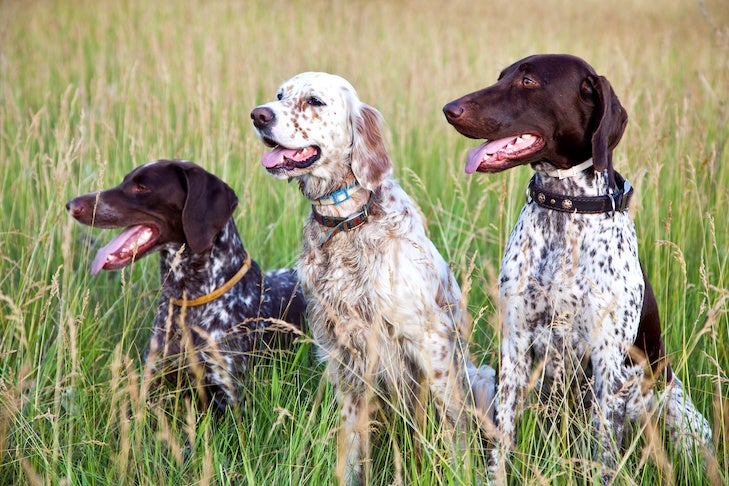
Originally bred as hunting companions, pointing breeds traditionally excel at tracking upland game for their owners. Sometimes referred to as “gun dogs” or “bird dogs,” Pointers specialize in pointing, as the name implies, and retrieving upland game birds. Many of the breeds are also good at retrieving waterfowl. When picking up the scent, they freeze, lift a paw, raise their tails, and aim their noses toward their target.
Active, intelligent, and enthusiastic, these high-energy dogs are eager to please. They willingly navigate across rugged terrain and retrieve in water in all types of weather. The pointing breeds are also athletic, fun-loving, and courageous. Dedicated to working as a partner with their owners, either by searching for prey away from their handler or waiting for instructions, they can also make endearing companions at home.
While other pointing breeds are enrolled in the AKC Foundation Stock Service (FSS), the American Kennel Club currently recognizes 14 pointing breeds as part of the Sporting Group. Each dog combines versatility, striking good looks, and loyalty. Which breed is right for you?
Bracco Italiano
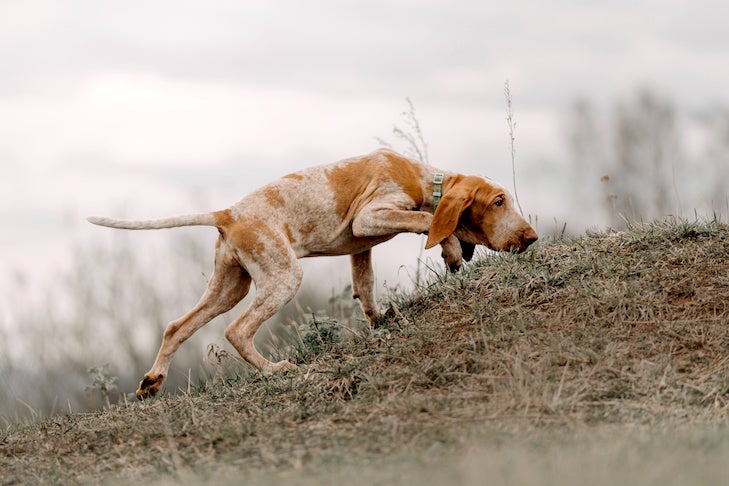
The Bracco Italiano was developed in Italy. The breed’s origins date back to the fourth and fifth centuries BC. In fact, their ancestors produced many modern European sporting and pointing breeds. Recognized by the AKC in 2022, this breed is a cross between sighthounds brought to Italy from Egypt and the Asiatic Mastiff.
With a noble expression, the hardworking Bracco Italiano is compliant, gentle, and calm at home but thrives when performing a job in the field. Sensitive and gentle, this pointing breed is friendly around other dogs and family members. The Bracco Italiano is also a quick learner.
Brittany
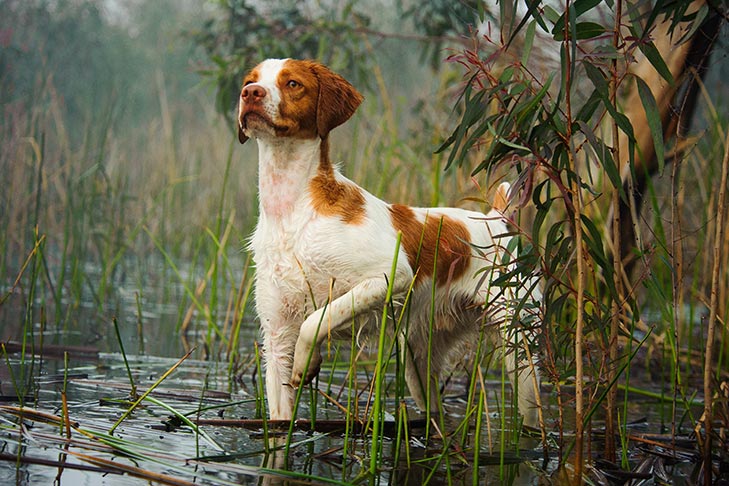
Medieval French peasants and poachers developed this pointing breed in Brittany, a rural region in northwestern France. These dogs became versatile bird dogs, medium in size and with coats that protected them from getting caught in the undergrowth. Interestingly, the Brittany’s name was officially changed in 1982 (from the Brittany Spaniel) once it was determined they were more similar to Pointers than Spaniels.
Today, the Brittany is still valued for stamina and excellent scent skills. Agile, fun-loving, and willing to please their owners, this Pointer needs plenty of exercise or hunting outings to keep them busy.
English Setter
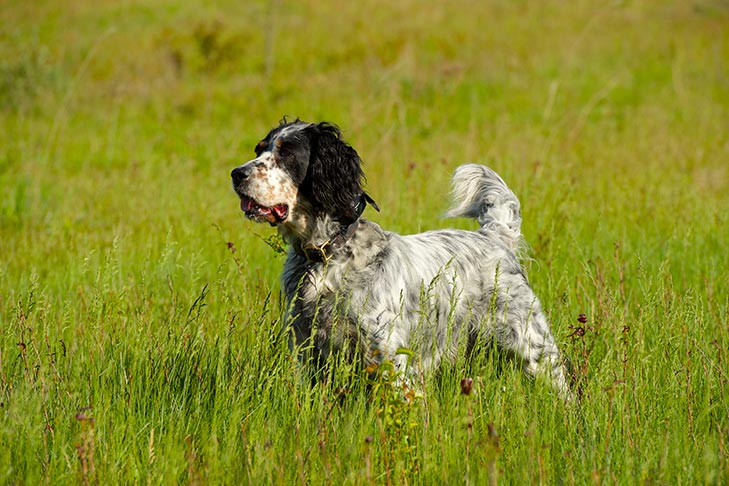
The English Setter is one of four British setters recognized by the AKC. According to the English Setter Association of America, this breed was developed 400 to 500 years ago to hunt across the diverse terrains of England, Ireland, and Scotland. Originally, the English Setter laid down (or “set”) when they located game birds. Eventually, this breed stood and pointed when finding prey.
Sweet-tempered with an elegant and uniquely speckled coat pattern called “belton,” this medium-sized sporting dog is known as a gentleman of the dog world. The English Setter is a fun-loving playmate at home and friendly with other dogs and people.
German Shorthaired Pointer

In the late 1800s, German hunters crossed hounds with pointing dogs for generations. Their goal was to produce a do-it-all-bird dog that could also be a good family companion, notes the German Shorthaired Pointer Club of America. This goal was achieved with the German Shorthaired Pointer. A natural hunter and retriever, the GSP excels in the field today, hunting everything from raccoons to deer.
An intelligent family watchdog and companion, the GSP is, first and foremost, a hunting dog and needs to be kept busy at home. Eager to please and a fast learner, this medium-sized Pointer has a distinctive coat pattern of ticking on a bright white background.
German Wirehaired Pointer
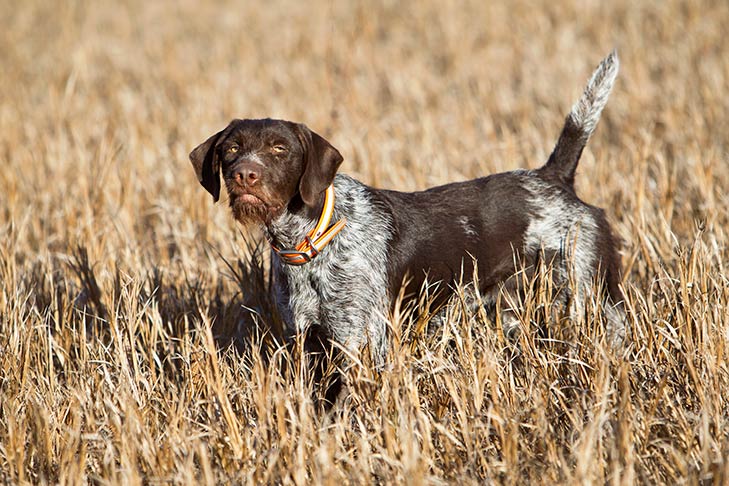
In the 19th century, German hunters also developed the German Wirehaired Pointer. This breed’s wiry, water-repellent coat protects them while they’re working in all types of weather and terrain. This harsh-coated, all-around gundog is a fearless hunting companion for one or more people. The GWP is also recognizable by their bushy beards and eyebrows.
A devoted companion, the medium-sized GWP serves as a watchdog for their family and property and enjoys participating in dog sports. Full of energy, this breed needs meaningful work to remain content.
Gordon Setter
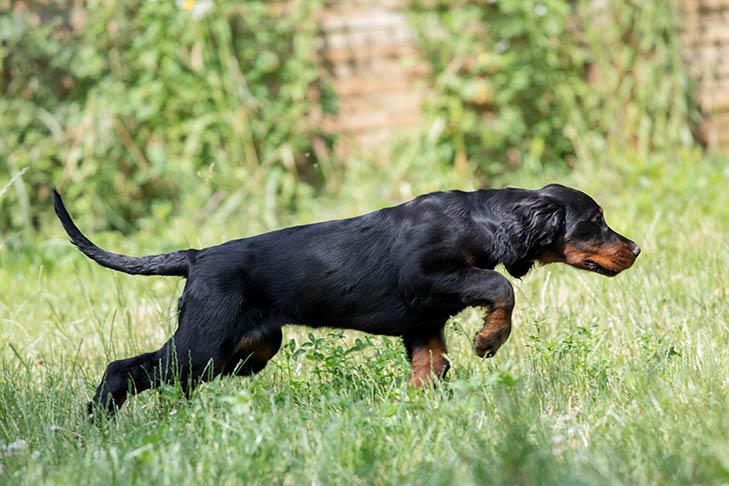
Alexander Gordon, a Scottish aristocrat and setter fancier, helped develop the Gordon Setter in the 19th century. He wanted this breed to successfully flush, point, and retrieve birds across Scotland’s rocky terrain.
Recognized in 1878 (six years before the AKC was formed), the Gordon Setter is now the largest of the setters. According to the AKC breed standard, males can measure up to 27 inches tall and weigh up to 80 pounds.
Gordons have lots of energy and an urge to run. Bold and athletic outdoors and confident and affectionate at home, the Gordon Setter thrives on spending time with their owners. Alert watchdogs, the breed is happy, enthusiastic, and known for their devotion and loyalty.
Irish Red and White Setter
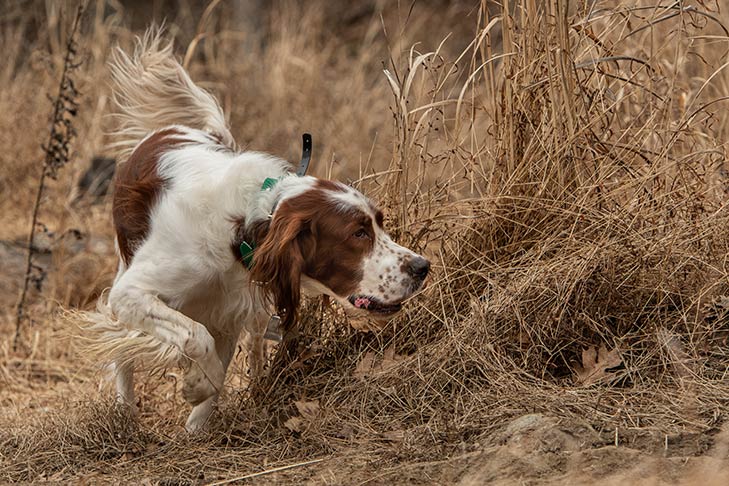
From the 1600s on, the Irish Red and White Setter was a fixture of Ireland’s hilly countryside. These dogs nearly went extinct during and after World War I, but the breed was revived in the 1920s. This dog was eventually recognized by the AKC in 2009.
Bred for hunting, these medium-to-large bird dogs help hunters find birds at a distance. They have a strong work ethic and love to run in the field all day. Fun-loving, friendly, and high-spirited, the Irish Red and White Setter is a cousin to the Irish Setter but is shorter and stockier. Around the house, this breed is an energetic and playful companion that’s loyal to their family.
Irish Setter

Irish hunters of the 1800s bred the sleek Irish Setter to cover the flat countryside of the Emerald Isle effortlessly. Their red coats became popular thanks to American visitors to Ireland, who fell in love with these crimson-coated dogs and exported them. This breed was first recognized in 1878, one of the nine breeds to achieve this status before the AKC’s formation.
A dynamic, strong, and graceful hunter, the Irish Setter enjoys participating in field trials today. The breed’s flowing, silky coat and soft expression turn heads wherever they go. This dog’s playful, fun-loving, and affectionate temperament is often described as “rollicking,” which aptly characterizes the Irish Setter’s mischievous and independent nature.
Pointer

The Pointer is an apt name for this breed’s job description. But they’re not a new breed since their ancestors may trace all the way back to ancient Egypt and then on to early modern Europe. In the 1700s, the Pointer became a devoted and durable gundog. In fact, they’re sometimes known as the “Cadillac of Bird Dogs.”
Willing to please their owners, the breed has an intense and natural affinity for finding, pointing, and retrieving game birds. Pointers love their families and get along well with other dogs when they’re not in the field. Today, the breed makes an excellent hunting companion and enjoys competing in hunt tests, field trials, and scent work.
Spinone Italiano

An ancient breed known for versatility in the field, the Spinone Italiano was bred to work alongside hunters in the hilly terrain of the Italian Alps. Spinone refers to “Pino,” the thorny undergrowth common in Italy’s Piedmont region. This breed may have resulted from crosses of coarse-haired Italian Setters left by Greek traders on the coast of the Adriatic Sea with white Mastiffs and perhaps French Griffons. The Spinone Italiano underwent a drastic decline during World War II, but the breed was revived in succeeding decades.
The breed’s unique profile, muscular build, and thick wiry coat give it a distinctive appearance, but the soft, sweet expression draws admirers. The breed is a loyal family member who insists on human companionship but also requires exercise and activity.
Vizsla
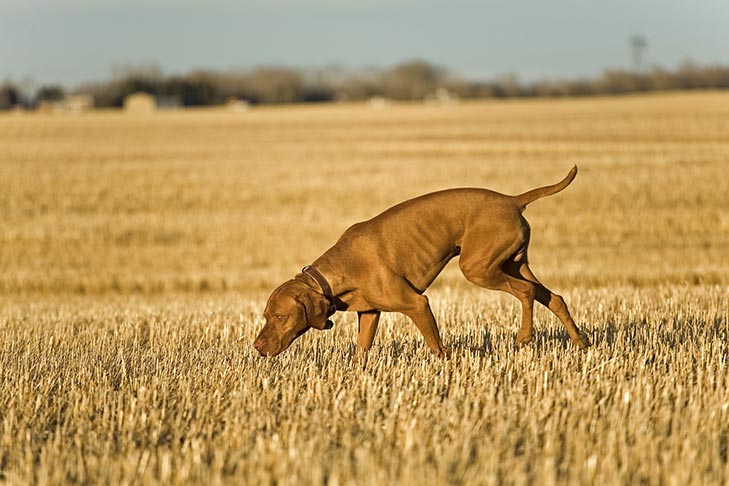
The Vizsla‘s earliest days began in the mid-800s. At this time, the Magyar cavalry of Hungary attacked Western Europe, reaching as far west as France. These nomadic warriors valued speed, agility, and toughness in their dogs. Centuries later, Hungarian nobles and warlords refined this breed into a swift, elegant, all-purpose hunting dog. These beloved dogs were brought to the United States after World War II, thanks to the efforts of Hungarian fanciers and American dog lovers who were curious about this unique breed.
With a distinctively rust-colored coat, the Vizsla has an affectionate, gentle, and enthusiastic personality. They are a popular choice for an owner who enjoys an active lifestyle. The breed thrives on daily exercise and retrieving and chasing in the field.
Weimaraner
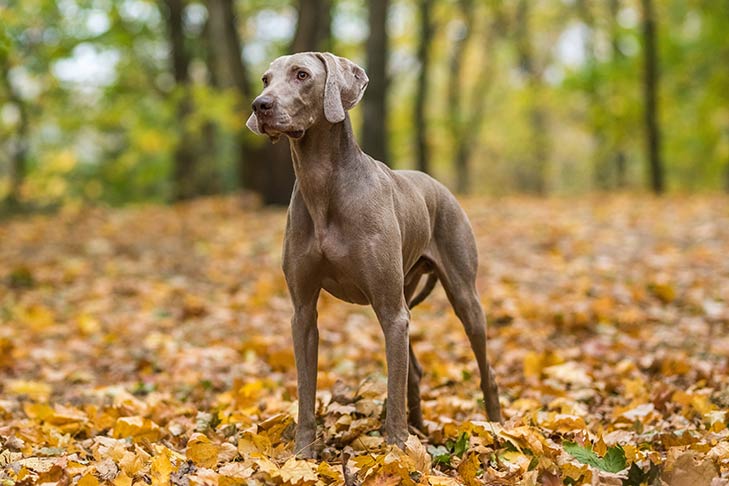
German aristocracy developed the Weimaraner in the early 1800s in the city of Weimar as an all-purpose hunting dog. Previously known as the Weimar Pointer, the Weimaraner is a cross between Bloodhounds and German and French hunting dogs. Initially used to pursue predators like bears, mountain lions, and wolves, the breed eventually found a new job pointing and retrieving game birds.
Recognized for its distinctive gray coat, the sleek and swift Weimaraner is sometimes known as the “Gray Ghost.” Friendly and graceful, with a streamlined body, the breed is affectionate and enjoys spending time with their owners. The breed requires require exercise and mental stimulation to stay happy.
Wirehaired Pointing Griffon
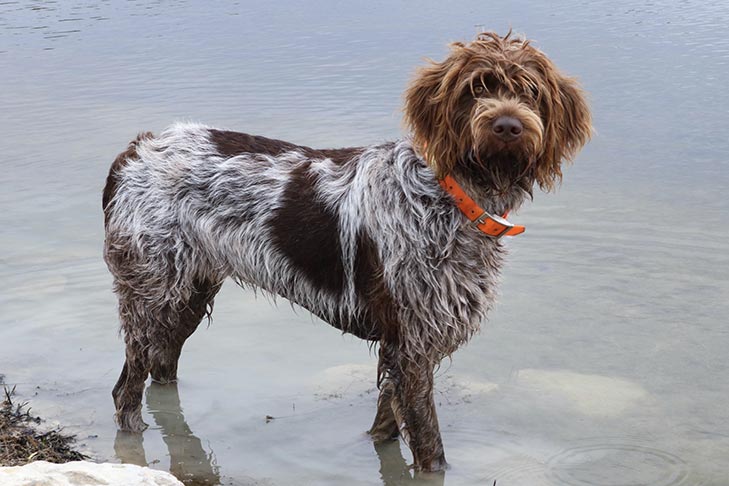
In the 1800s, Eduard Korthals, a passionate hunter, developed the Wirehaired Pointing Griffon by crossing several breeds. The sportsman wanted a dog that could work as a pointer on dry land and flawlessly retrieve in watery terrains like marshes and swamps. As a result, the breed’s webbed toes make them excellent swimmers. Since most of the breed’s development occurred in France, Wirehaired Pointing Griffons are actually considered to be a French breed, despite Korthals’ Dutch origins.
The breed’s naturally unkempt appearance and extremely harsh, bristly, and low-shedding coat appeal to many. Friendly, devoted, and intelligent, the Wirehaired Pointing Griffon is affectionate with family.
Wirehaired Vizsla
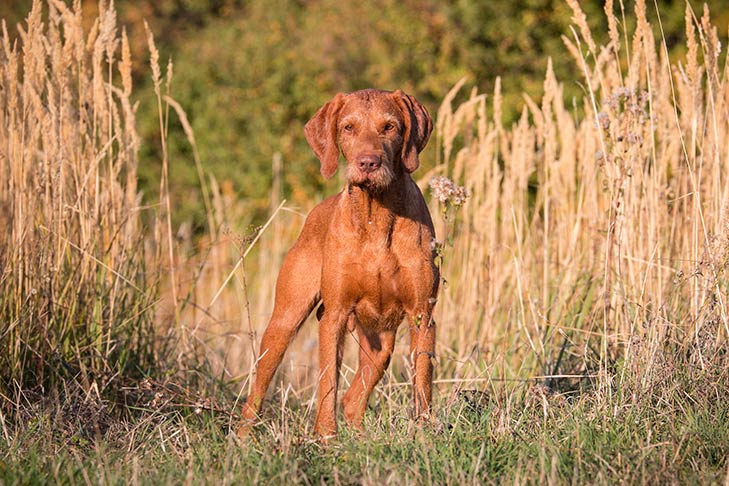
Wirehaired Vizslas came about in the 1930s, courtesy of Hungarian hunters and falconers who crossed Vizslas and German Wirehaired Pointers. These sportsmen wanted a dog like the Vizsla, but one that was ideally suited to work in northern Hungary’s rough terrain and cold weather. The result is the exuberant Wirehaired Vizsla, which sports a stockier frame and a denser, wiry coat.
With its striking golden-rust coat, the medium-sized Wirehaired Vizsla is a calm, gentle, and loyal companion. With a sensitive and strong desire to please, this breed enjoys working in the field, forest, or water and loves to swim.

